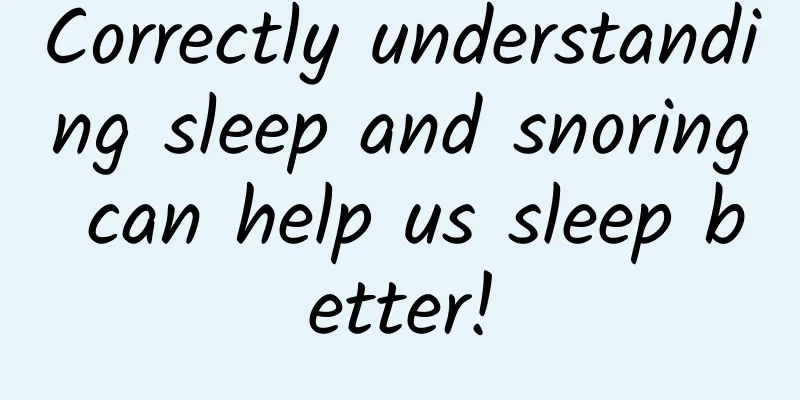Correctly understanding sleep and snoring can help us sleep better!

|
Author: Wu Xiaoli, deputy chief physician of China Rehabilitation Research Center Reviewer: Gong Weijun, Chief Physician, Beijing Rehabilitation Hospital, Capital Medical University As the saying goes, "A good night's sleep is better than a tonic." After a day's activity, our body can rest and relieve fatigue through sleep at night. Therefore, sleep is very important for maintaining good health. However, most people believe that snoring during sleep is a sign of a good and restful sleep. Is this really the case? Let's uncover this mystery layer by layer. Figure 1 Copyright image, no permission to reprint 1. What changes are happening to our bodies during sleep? Since researchers first successfully detected human brain currents in 1924, subsequent EEG studies have given us a more objective and in-depth understanding of sleep. Based on the characteristics of brain waves during sleep, taking 8 hours of sleep as an example, the entire night will generally experience 4 to 5 sleep cycles, each of which is about 90 minutes. Each cycle will experience four stages: falling asleep, light sleep, deep sleep, and rapid eye movement sleep. Figure 2 Copyright image is not authorized for reproduction The body will undergo different changes in different sleep stages. As sleep deepens, the body will become more and more relaxed, muscles will relax, breathing and heart rate will slow down, brain waves will slow down, and gradually enter the deep sleep stage, also known as the "slow wave sleep" stage. "Slow wave sleep" is very important for the human body. Sufficient "slow wave sleep" can promote the secretion of growth hormone, relieve fatigue, ensure the recovery of the body's physical strength, remove garbage in the brain, enhance memory, and improve learning ability. 2. What is snoring? Under normal circumstances, when we breathe, the gas enters the lungs through the oral cavity, nasal cavity and pharyngeal cavity for gas exchange, ensuring the body's blood oxygen supply and expelling carbon dioxide produced by the body's metabolism. When we are in a state of sleep, as the degree of sleep gradually deepens, the muscle tissue around the throat becomes relaxed, and the tissue around the pharyngeal airway falls. Generally speaking, this muscle relaxation and falling does not affect the patency of the airway, and the activities of the chest and abdomen are also normal. However, when any part that affects the passage of air is narrowed, such as obesity leading to increased fat tissue in the throat wall or thickened nasal conchae, the collapse of the airway becomes more obvious as the muscles relax after falling asleep at night. When the airflow passes through the narrow part, vortices are generated, causing vibrations and snoring. If the upper airway soft tissue and muscles collapse further, it will lead to airway obstruction, and the respiratory airflow will disappear or be restricted, resulting in a decrease in the oxygen concentration in the blood and an increase in the carbon dioxide concentration. When CO2 reaches a certain concentration, it will stimulate and awaken the brain, causing cortical micro-awakening, driving the respiratory center, thereby promoting the contraction of respiratory-related muscles such as the chest and abdomen, promoting the reopening of the upper airway, opening the respiratory airflow, gradually expelling CO2, restoring the body's oxygen supply, and allowing the patient to fall asleep again. This process occurs repeatedly throughout the night, and the clinical manifestations are snoring or frequent sleep apnea during sleep. Figure 3 Copyright image, no permission to reprint 3. Are snoring and sleep apnea harmful to the body? The answer is yes. Frequent sleep apnea at night can cause intermittent hypoxia in the brain and body, leading to frequent micro-awakenings of the brain, shortened sleep cycles or disrupted sleep structure, making it difficult for the body to enter "slow-wave sleep", or reducing "slow-wave sleep", resulting in poor sleep quality. The brain and body cannot get enough rest and cannot effectively eliminate fatigue. This will lead to dry mouth in the morning, daytime sleepiness, drowsiness, poor spirits, etc. Long-term poor sleep quality and lack of sleep will further lead to memory loss, slow reaction, and even chronic diseases such as hypertension and coronary heart disease. Figure 4 Copyright image, no permission to reprint As for children, due to their growth and development needs, they need longer slow-wave sleep than adults. If children have snoring and sleep apnea, long-term intermittent hypoxia and brain micro-awakening will cause a decrease or shortening of slow-wave sleep, poor sleep quality, and reduced secretion of growth hormone at night. As they age, they will experience slow growth, decreased attention, memory, and learning ability. If accompanied by airway obstruction, it will lead to long-term open-mouth breathing, resulting in shortened mandible and facial changes. Figure 5 Copyright image, no permission to reprint 4. What methods can be used to evaluate our sleep conditions? During sleep, the brain undergoes changes in brain waves, accompanied by corresponding changes in the body. Polysomnography (PSG) is equipped with brain electrodes that can be used to monitor changes in brain waves during sleep. It is equipped with related electrodes for monitoring muscle activity, eye movement, and ECG activity, as well as accessories for evaluating respiratory airflow, blood oxygen levels, and chest and abdominal movement. These indicators can be comprehensively analyzed to determine whether there are abnormalities in sleep, such as insomnia, sleep apnea, periodic leg movements, etc., through accurate sleep staging. Some clinical hospitals match synchronous video monitoring, which can more intuitively observe behavioral states during sleep, such as sleepwalking, shouting, and falling. Polysomnography is currently also considered the gold standard for diagnosing sleep apnea. 5. Under what circumstances is it necessary to check whether you have sleep apnea syndrome? If your family members report that you snore or have apnea during sleep, and if you have related symptoms during the day and at night, you need to go to a specialist hospital for further treatment. At present, due to the complexity of the cause of the disease, treatment may involve cooperation among multiple disciplines, such as otolaryngology, neurology, sleep specialists, respiratory medicine, dentistry, surgery, etc. You can visit the corresponding department depending on your own situation and the situation of the local hospital. Figure 6 Copyrighted images are not authorized for reproduction 6. If sleep apnea is diagnosed, how should it be treated? 1. Symptoms can generally be alleviated by sleeping in the side-lying position, exercising appropriately, and controlling weight. 2. If you are just overworked, for example, working overtime, drinking and getting drunk, and snoring during sleep, but it will be relieved after rest, then you can observe this situation first. Some women will also snore during sleep due to changes in hormone levels and weight after pregnancy. Snoring symptoms will gradually disappear after childbirth. If snoring still exists after childbirth, you can see a doctor for further investigation. 3. If sleep apnea is confirmed, the next step of treatment can be determined based on the type of sleep apnea, the number of apneas per hour at night (AHI), and the degree of hypoxia in the blood. (1) For some patients with obstructive sleep apnea syndrome related to body position, resting in the side-lying position can improve the airflow obstruction and hypoxia caused by airway collapse during sleep at night. (2) For children who have enlarged adenoids or tonsils that cause narrowing of the respiratory tract, snoring during sleep, or even waking up at night due to suffocation, surgical treatment is usually required. Surgical methods include adenoids ablation and dental correction/orthodontics. (3) Some patients may visit an otolaryngologist to check for upper airway conditions, such as nasal polyps, deviated nasal septum, chronic rhinitis, turbinate hypertrophy, etc., and receive targeted medication or surgical treatment, such as nasal septum or nasal surgery (nasal expansion surgery, three-line septum tensioning surgery), velopharyngeal surgery (uvula palatopharyngeal surgery), and mandibular advancement surgery. (4) For patients with obvious snoring, moderate to severe sleep apnea and hypoxia, or obvious daytime sleepiness and fatigue, non-invasive positive pressure ventilation (Continuous Postive Airway Pressure, CPAP) is the first choice. By continuously applying pressure ventilation to the airway, it supports the upper airway and prevents collapse and blockage, thereby alleviating hypoxia. Figure 7 Copyright image is not authorized for reproduction (5) For patients with simple snoring or mild to moderate obstructive sleep apnea accompanied by mandibular retraction, who cannot tolerate non-invasive positive pressure ventilation treatment, cannot undergo surgery or have poor surgical results, oral appliances can be used as a supplement or alternative treatment measure to CPAP treatment. Figure 8 Copyright image, no permission to reprint |
<<: Revealed: Ancient China's metal smelting technology and mineral mining "black technology"
>>: Can eating konjac help you lose weight? Pay attention to these two points!
Recommend
Operational skills of Alipay products!
It turns out that Alipay is not only a payment pr...
How can online education retain traffic?
As an observer of the education and training indu...
How to do content operation well? 3 major elements!
Since I entered the Internet industry, I have bee...
24-hour emergency response | College teachers and students must provide a 48-hour nucleic acid test certificate before returning to school
Hot News TOP NEWS College teachers and students m...
Analysis of offline marketing activity process!
Based on a large-scale electrical appliance marke...
Price hikes saved Gong Yu but not iQiyi
This week, iQiyi announced a new round of members...
promovie Food Photography Practical Master Course
: : : : : : : : : : : : : : : : : : : : : : : : : ...
English-speaking countries prefer iOS, while non-English-speaking countries are dominated by Android
According to a new report from DeviceAtlas, Engli...
Vaccines are useless against Omicron? Rumors on the March "Science Rumors List"
1. HPV vaccine can cause infertility Rumor: Getti...
What do the HTTP status codes in website logs mean? What does it mean?
Friends who do website SEO optimization know that...
Case review + fission methodology | Why is your fission activity ineffective?
I recently chatted with a fellow operations partn...
Live streaming craze is fading, and losses of online celebrity e-commerce may become the norm
When it comes to Hangzhou Ruhan Holding Co., Ltd....
Crazy hoarding makes you a big fat ball! Check out the animals that love to "hoard food"
Severe cold weather is always more difficult for ...
Don't argue about who is the leader between Geely and Great Wall. Everyone is buying Changan cars.
Recently, I have noticed that more and more cars ...
There is a volcano in Inner Mongolia that makes a heart shape. Don’t believe it? Look!
The Arxan-Chaihe Volcanic Group (also known as th...









